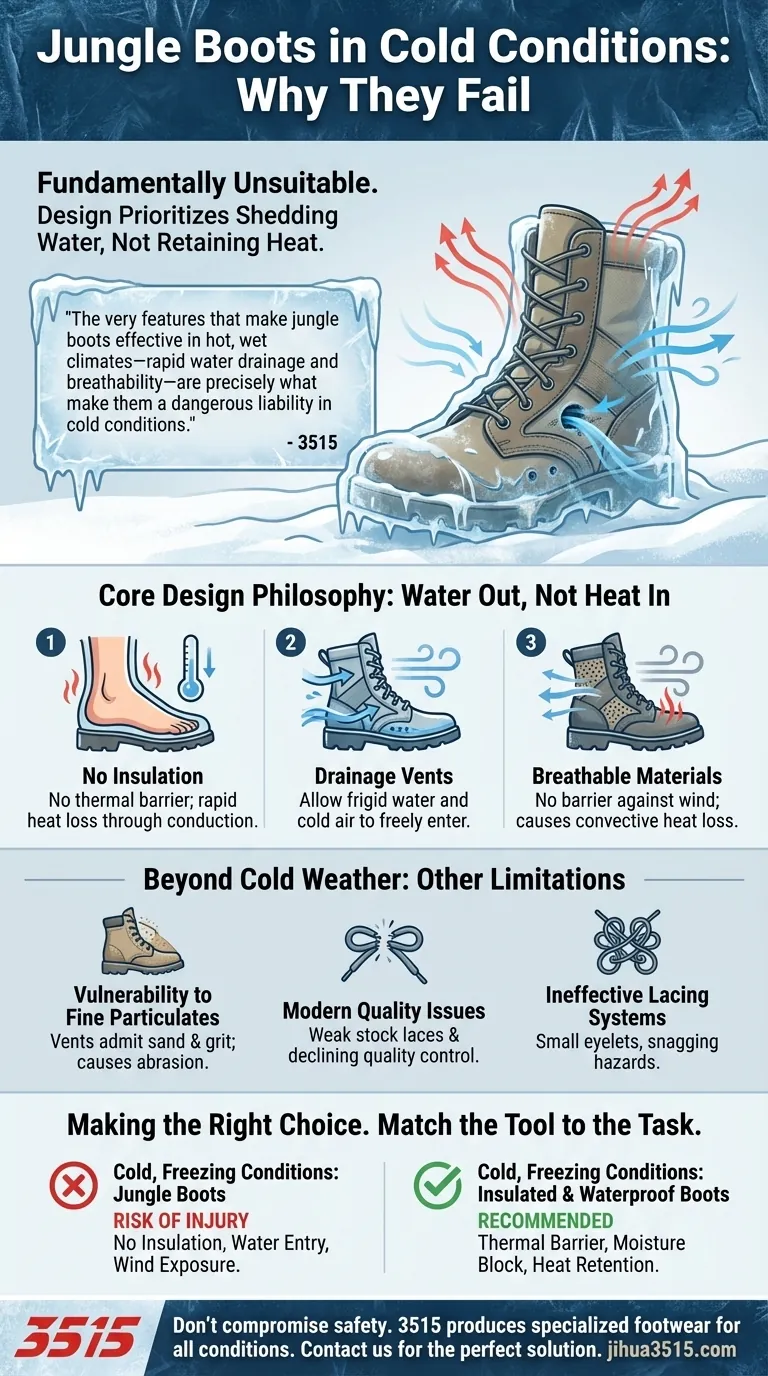In short, jungle boots are fundamentally unsuitable for cold conditions. Their design actively works against the principles of cold-weather protection. They offer no insulation and are built to be highly breathable and quick-draining, which means they will readily let cold air and water in, leading directly to cold, wet feet and the risk of serious cold-weather injuries.
The very features that make jungle boots effective in hot, wet climates—rapid water drainage and breathability—are precisely what make them a dangerous liability in cold conditions. Their design prioritizes shedding water, not retaining heat.

The Core Design Philosophy: Water Out, Not Heat In
To understand the limitations of jungle boots, you must first understand their original purpose. They were engineered for tropical environments where feet are constantly submerged. In these conditions, a waterproof boot is useless because water will simply pour in over the top.
A Complete Lack of Insulation
The primary failure point is the absence of insulation. Cold-weather boots use layers of material to trap air, creating a thermal barrier between your foot and the outside cold. Jungle boots have no such layers. Any heat your body generates is immediately lost to the environment through conduction.
The Role of Drainage Vents
Most jungle boots feature small, screened vents near the sole. In a jungle, these are critical for pushing water out with every step, preventing trench foot. In the cold, these vents become a significant weakness, allowing frigid water and cold air to freely enter the boot, rapidly chilling the foot.
Highly Breathable Materials
The canvas and nylon uppers are designed for maximum airflow to help feet dry in humid air. This high level of breathability means there is no barrier to prevent cold wind from penetrating the boot and stripping heat away from your foot, a process known as convective heat loss.
Understanding the Full Spectrum of Limitations
Beyond their failure in cold weather, it's important to recognize that jungle boots are a specialized tool with other inherent trade-offs that limit their use in different environments.
Vulnerability to Fine Particulates
The same drainage vents that are problematic in the cold can also cause issues in other terrains. In deserts or on silty riverbanks, these vents can allow fine sand and grit to enter the boot, leading to severe abrasion, blisters, and discomfort over time.
Modern Quality and Design Issues
Many modern reproductions of classic jungle boots suffer from declining quality control. Common complaints include weak stock shoelaces that snap under strain and are often immediately replaced with paracord.
Ineffective Lacing Systems
The eyelets and fittings on some models are too small to work effectively with the thicker paracord used for replacement laces. Furthermore, these prominent fittings can easily snag on dense vegetation, creating a tripping hazard.
Making the Right Choice for Your Environment
Choosing footwear is about matching the tool to the task. Using a jungle boot outside of its intended environment is not only ineffective but can be dangerous.
- If your primary focus is hot, humid, and wet environments: A jungle boot is a viable option, as its ability to drain and dry quickly is a key advantage.
- If your primary focus is cold, freezing, or snowy conditions: You must select an insulated and preferably waterproof boot designed specifically to retain heat and block moisture.
- If your primary focus is desert or fine-sand terrain: Be aware that the drainage vents are a significant liability and can lead to foot damage from grit and sand.
- If you need a versatile, all-around hiking boot: A modern leather or synthetic boot with a waterproof membrane like Gore-Tex offers a much better balance of protection for varied conditions.
Ultimately, selecting the right boot means matching its specific design to the non-negotiable demands of your environment.
Summary Table:
| Limitation | Impact in Cold Conditions |
|---|---|
| No Insulation | Rapid heat loss; feet cannot retain warmth. |
| Drainage Vents | Allows cold air and water to enter freely. |
| Breathable Materials | No barrier against wind, causing convective heat loss. |
| Specialized Design | Prioritizes water drainage, not heat retention. |
Don't let the wrong footwear compromise your safety or performance. 3515, as a large-scale manufacturer, produces a comprehensive range of specialized footwear for distributors, brand owners, and bulk clients. Whether you need insulated boots for cold climates, durable hiking boots for varied terrain, or any other type of shoe or boot, our extensive production capabilities ensure you get the right tool for the job. Contact our team today to discuss your specific needs and find the perfect footwear solution.
Visual Guide

Related Products
- Wholesale Waterproof Tactical Boots Custom Suede & High-Traction Soles
- High-Traction Suede Tactical Boots Wholesale & Custom Manufacturing
- Durable Leather High-Ankle Tactical Boots for Wholesale & Custom Manufacturing
- Durable Leather Tactical Boots Wholesale & Custom Manufacturing for Brands
- Wholesale Lightweight Tactical Boots with Dial Closure OEM & Bulk Orders
People Also Ask
- What is the significance of waterproof functionality in tactical boots? Essential for Health & Performance
- What waterproof technology is used in tactical boots? Unlock All-Weather Performance & Protection
- How do uniform requirements influence the choice between tactical boots and sneakers? Select Compliant Footwear for Your Role
- Are military camouflage boots waterproof? How to Choose Boots That Keep Feet Dry
- What are the advantages and disadvantages of waterproof tactical boots? A Guide to the Key Trade-Offs



















